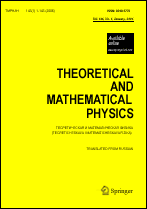|
This article is cited in 2 scientific papers (total in 2 papers)
Nonideal Bose Gases: Correlation Inequalities and Bose Condensation
A. Bernala, M. Corginia, D. P. Sankovichb
a Universidad de La Serena
b Steklov Mathematical Institute, Russian Academy of Sciences
Abstract:
We consider two simple model systems describing effective repulsion in a nonideal Bose gas. The interaction Hamiltonians in these systems can be analytically represented as functions of the occupation number operators for modes with nonzero momenta ($p\neq0$). One of these models contains an interaction term corresponding to repulsion of bosons with the mode $p=0$ and ensuring the thermodynamic superstability of the system; the other model does not contain such a term. We use the Bogoliubov–Dirac–Ginibre approximation and the method of correlation inequalities to prove that a Bose condensate can exist in these model systems. Because of the character of interaction, the condensate can be formed in the superstable case for any values of the spatial dimensions, temperature, and positive chemical potentials.
Keywords:
nonideal Bose gas, Bose condensation, stability, self-consistency equation, Fock space.
Received: 30.01.2003
Revised: 04.09.2003
Citation:
A. Bernal, M. Corgini, D. P. Sankovich, “Nonideal Bose Gases: Correlation Inequalities and Bose Condensation”, TMF, 139:3 (2004), 499–511; Theoret. and Math. Phys., 139:3 (2004), 866–877
Linking options:
https://www.mathnet.ru/eng/tmf64https://doi.org/10.4213/tmf64 https://www.mathnet.ru/eng/tmf/v139/i3/p499
|


| Statistics & downloads: |
| Abstract page: | 463 | | Full-text PDF : | 216 | | References: | 85 | | First page: | 1 |
|




 Contact us:
Contact us: Terms of Use
Terms of Use
 Registration to the website
Registration to the website Logotypes
Logotypes









 Citation in format
Citation in format 
